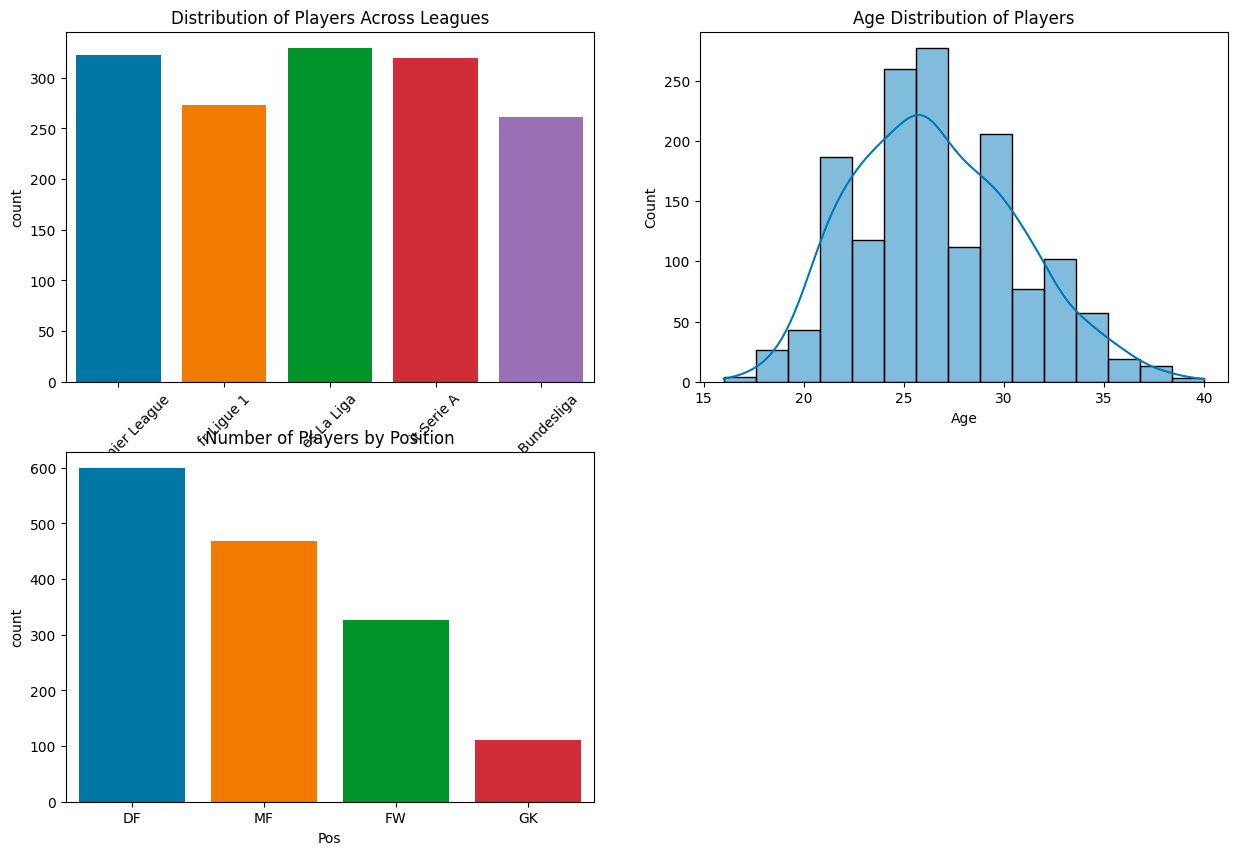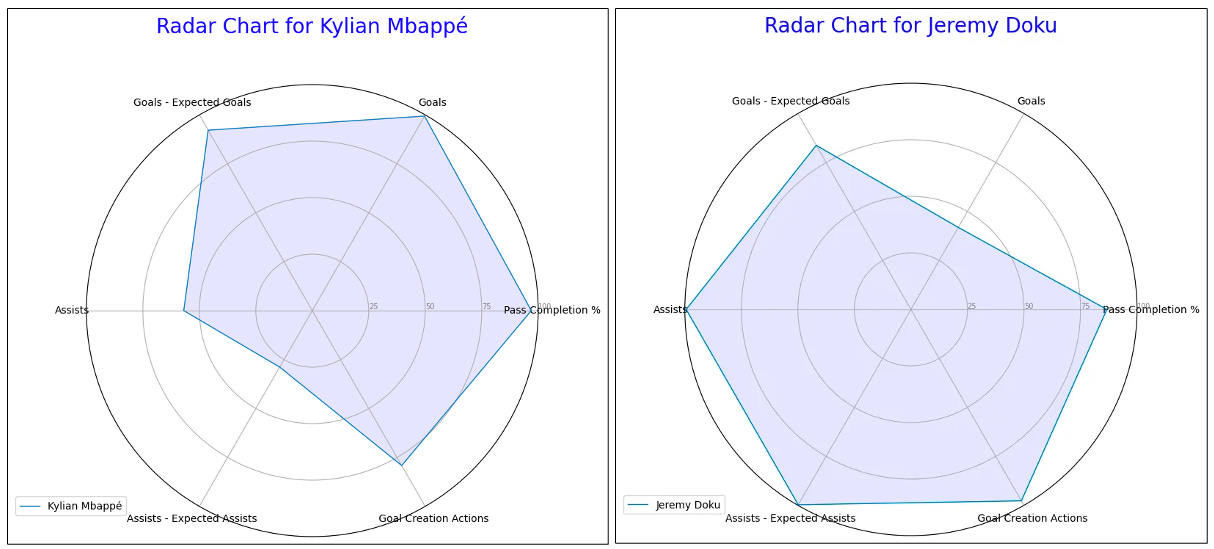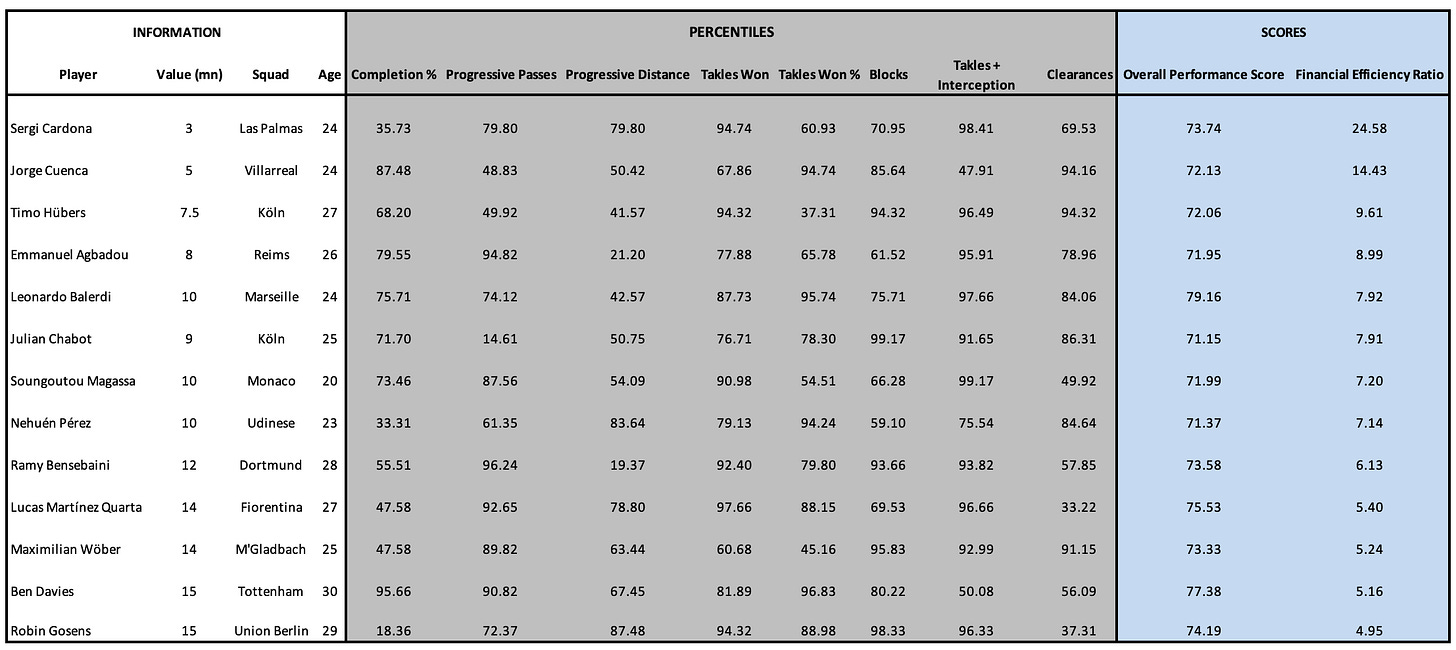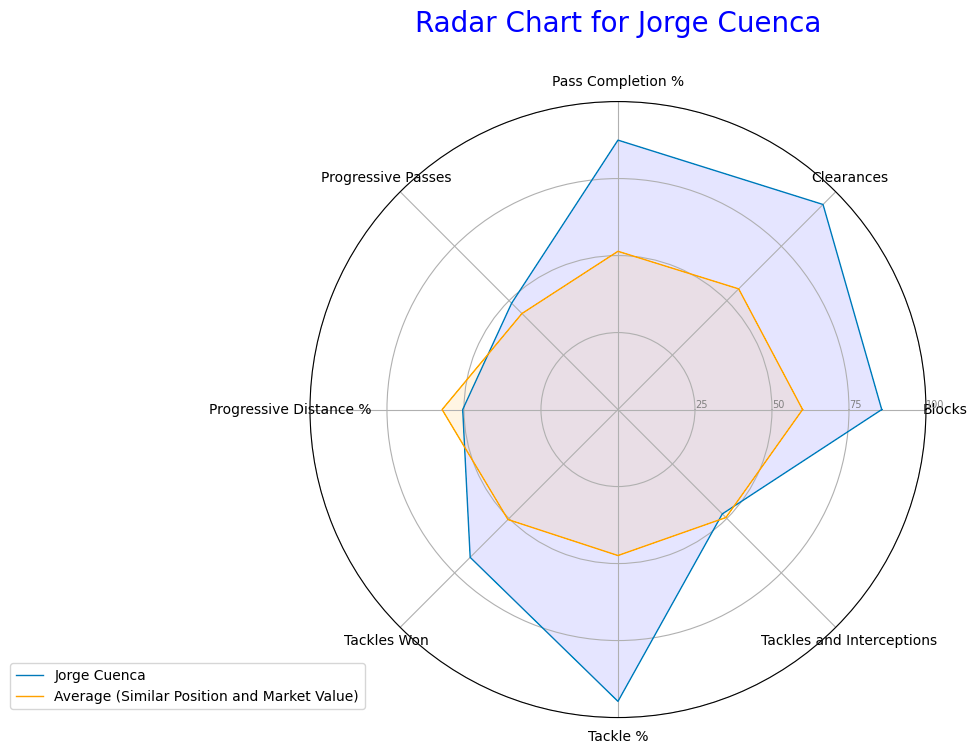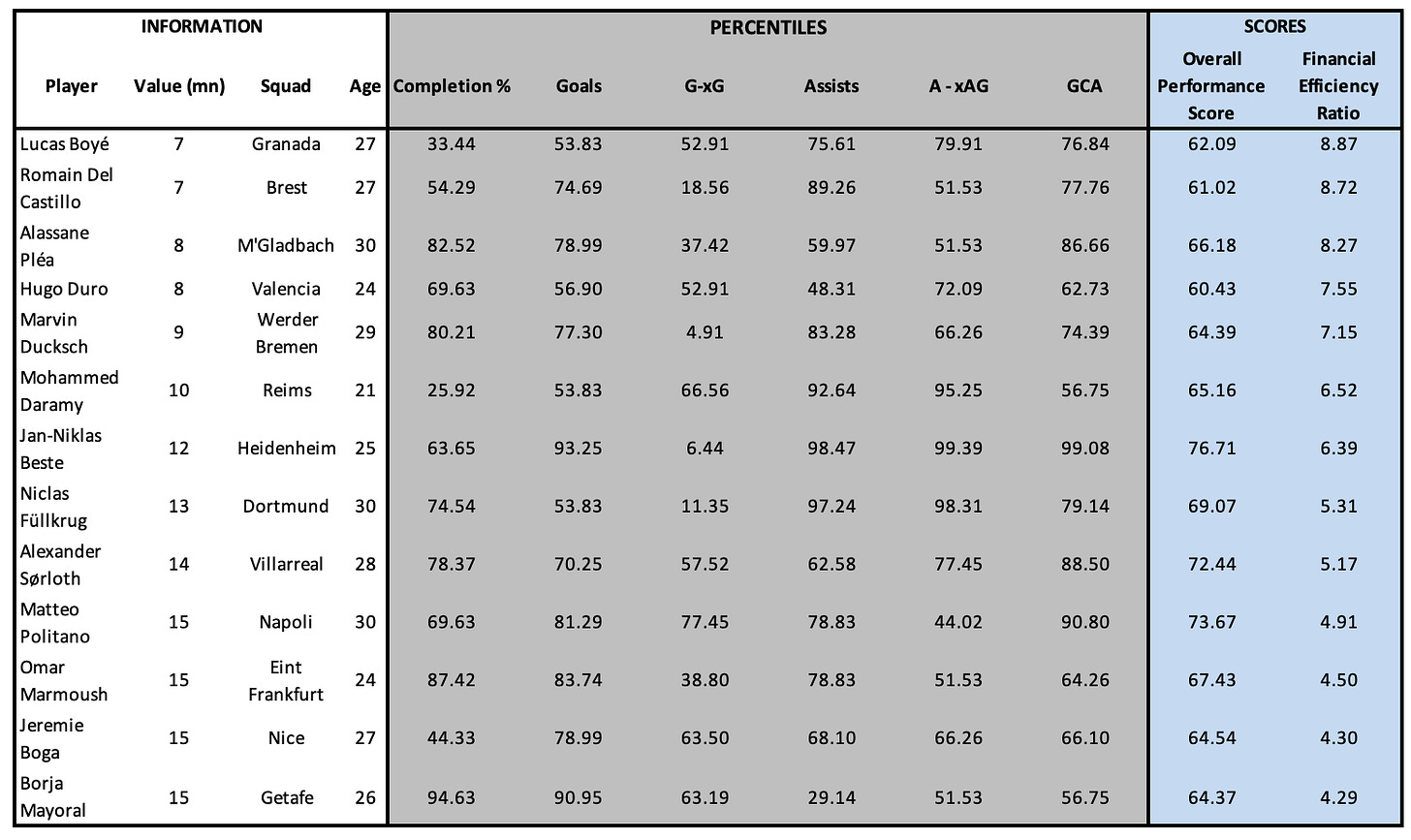Efficiency Over Expectation: Analyzing Soccer Player Performance vs. Market Value in Top European Leagues
As the winter transfer window unfolds amidst the thrilling halfway mark of the top 5 European football leagues, clubs and fans alike turn their eyes towards potential signings that could redefine their season. In this era where data analytics intertwine seamlessly with traditional scouting, understanding a player's true worth extends far beyond mere reputation and into the realms of statistical evidence.
This article delves into a data-driven analysis, focusing on the top 5 European leagues - Premier League, La Liga, Bundesliga, Serie A, and Ligue 1. By harnessing a comprehensive dataset encompassing player statistics and market values, we try to uncover players who not only exhibit strong on-field performance but also present significant value for money in the current market - a critical consideration during the winter mercato window.
Our methodology is rooted in evaluating players based on a range of position-specific metrics. For forwards, the spotlight is on goal-scoring prowess and efficiency. Midfielders are assessed through a blend of offensive and defensive contributions, while defenders are scrutinized based on their effectiveness in disrupting opposition plays. This exploration isn't only about identifying top talent; it's about finding players whose market values may not align with their performances.
As we navigate through this analytical expedition, we aim to offer clubs and enthusiasts insights into players who could be the key to success in the season's second half and beyond.
Data Insights and Position-Specific Metrics
Our analysis begins with a comprehensive dataset encompassing detailed player statistics and current market values from the top 5 European leagues from FBREF and Transfermarkt respectively.
To ensure a nuanced assessment, we have selected specific metrics for each position - forwards, midfielders, and defenders - based on their relevance and impact on the game. These metrics include traditional stats like goals and assists, as well as advanced metrics such as Expected Goals (xG), Key Passes, and the difference between Assists and Expected Assisted Goals (A-xAG).
The dataset contains data on more than 1,500 players distributed as below.
For a tailored evaluation, we've pinpointed metrics (per 90 minutes) that resonate with the specialized functions of each position on the field:
Forwards (FW)
Goal Metrics (Gls, G-xG): Measure scoring efficiency and the ability to exceed expected outcomes.
Playmaking Metrics (Cmp%, Ast, A-xAG): Assess quality in link-up play and creating opportunities beyond scoring goals.
Impact Metrics (GCA90): Reflect the rate of goal-creating actions, underscoring influence on the team's offensive play.
Midfielders (MF)
Distribution Metrics (Cmp%, PrgDist%): Indicate precision and ability to drive the ball forward effectively.
Creativity Metrics (Ast, A-xAG, KP): Capture the ability to craft goal-scoring opportunities.
Advancement Metrics (PFT, PrgP): Quantify impact on moving the ball into key attacking zones.
Opportunity Metrics (SCA90, GCA90): Highlight contributions to both shot-creating and goal-creating actions.
Defensive Metrics (Tkl%, Tkl+Int): Reflect prowess in ball recovery and defensive interventions.
Defenders (DF)
Ball Management Metrics (Cmp%, PrgP, PrgDist%): Evaluate the defender's contribution to building up play from the back.
Challenge Metrics (TklW, Tkl%, Tkl+Int): Show effectiveness in winning tackles and asserting defensive dominance.
Protective Metrics (Blocks, Clr): Indicate the ability to shield the goal and clear threats, essential for maintaining defensive solidity.
Calculating Player Performance Scores and Financial Efficiency
We then calculated percentiles for the aforementioned metrics based on the player’s position on the field. These percentiles are a way to standardize player performance across the board, making it possible to compare players in different leagues and positions. By ranking each player against their peers and calculating the percentage of players they outperform, we obtain a percentile score for each metric.
To synthesize these metrics into an overall performance score, we took the average of the percentile ranks across all relevant metrics. This aggregate score reflects a player's all-around capabilities and efficiency on the field, distilled into a single comprehensible figure.
Moving beyond performance on the pitch, we sought to integrate a financial perspective into player valuation. To achieve this, we divided the overall performance score by the player's market value, creating what we refer to as the 'Financial Efficiency Ratio'. This ratio serves as an indicator of value for money, highlighting players who deliver high performance relative to their potential cost in the transfer market.
This financial efficiency ratio allows clubs, scouts, and analysts to identify players who may be undervalued in the market — those whose performance merits a higher valuation. It's a tool that can be particularly valuable for clubs operating under budget constraints, looking to make strategic signings that promise both high on-field impact and sound financial investment.
Highlighting Top Performers with Low Market Value
In assessing the financial efficiency of soccer players, it's crucial to recognize that a player's market value is not solely a reflection of on-field performance. Factors such as the remaining length of a player's contract and their age play significant roles in determining this figure.
It is a common occurrence in the transfer market to observe experienced, prolific players, especially those approaching the twilight of their careers or nearing the end of their contracts, being positioned favorably in terms of financial efficiency. This phenomenon can be attributed to the reduced transfer fees they command due to the shorter term left on their contracts or the expectation of a diminishing future contribution as they age. Olivier Giroud and Andrea Belotti are perfect examples in the scatter plot above.
To refine our analysis, we have decided to highlight the financially efficient players who are under 30 years old. This age criterion ensures that we are focusing on players who are likely to sustain their performance levels for a longer period, thus providing a balance between immediate impact and potential long-term contribution.
Moreover, it's important to acknowledge that limited playing time can skew a player's performance score, particularly when metrics are normalized on a per-game basis. (e.g. Luka Jovic above, with minutes played equivalent to 5 games). To mitigate this, our analysis will concentrate on players who have amassed playing time equivalent to 10 games or more during the current season. This threshold helps to ensure that the performance scores we consider are based on a substantial amount of playing time, thus providing a more reliable and accurate reflection of a player's capabilities on the field.
While there is an understandable positive correlation between performance scores and market value — with the latter often accounting for a player's potential and future performance — our model is specifically tailored to gauge immediate on-pitch effectiveness. Consequently, we are interested in uncovering players, valued below €15 million, who can offer immediate benefits to a team. These players represent a sweet spot of financial prudence and immediate performance readiness, making them highly sought-after targets for clubs looking to strengthen their squads smartly without breaking the bank.
Defenders
Our pick: Jorge Cuenca, a 24-year-old centre-back playing for Villarreal in La Liga - market value: €5 million.
The radar chart below visualizes the relevant statistics, showing that Cuenca's standout attributes are his tackle success rate, pass completion, clearances, and blocks with his performance in these areas being significantly above players with a similar market value. His progressive passes and distance metrics are around average, suggesting that while he is capable in these areas, they are not his standout attributes.
Overall Performance Score: Jorge Cuenca's overall performance score is around the 72nd percentile, indicating that he performs better than approximately 72% of all defenders among the 5 major european leagues. This high overall score reflects a well-rounded and solid defender.
Financial Efficiency Ratio: With a value ratio of 14.43 (average of 8.75 for players playing at a similar position), it suggests that compared to other players with a market value of €5 million, Cuenca offers a high performance per monetary unit. This ratio can be particularly appealing for clubs seeking cost-effective transfers, as it suggests that Cuenca's on-field contributions are of high value relative to his market price.
In conclusion, Jorge Cuenca's stats profile him as a strong defensive asset, particularly in clearances, pass completion, and tackling, with an overall performance that makes him a financially efficient player to consider for teams looking to reinforce their defense. Next summer, Jorge Cuenca’s will only have one year remaining on its contract.
Midfielders
Our pick: Angelo Stiller, a 22-year-old defensive-midfielder playing for VfB Stuttgart in Bundesliga - market value: €14 million.
The radar chart for Angelo Stiller accentuates his proficiency in key playmaking metrics such as key passes, passes to the final third, and a notably high pass completion rate, illustrating his effectiveness in ball distribution and chance creation. His ability to exceed his expected assists indicates a knack for setting up scoring opportunities that surpass the average forecast for players within his market value range. Stiller delivered 3 assists in 15 appearances in Bundesliga this season so far. His progressive passing and distance metrics are commendable, denoting a reliable capability in advancing play, although they do not stand out as his primary attributes.
Overall Performance Score: With an overall performance score placing him in the 82nd percentile, Angelo Stiller outperforms roughly 82% of midfielders in the major European leagues (only Joshua Kimmich ranks higher if we consider only midfielders of 30 years old or less). This impressive percentile ranking demonstrates Stiller's robust and impactful presence in the midfield.
Financial Efficiency Ratio: Stiller's value ratio is attractive, indicating that for a market value of €14 million, his performance is substantially more efficient monetarily compared to peers. This metric positions him as an exceptionally attractive proposition for clubs aiming for high-value acquisitions without the premium expense. His performance relative to cost suggests a savvy investment for teams prioritizing strategic financial planning and on-field competence.
Accounting for Stiller’s young age, his value as a strategic acquisition is further amplified, offering clubs the opportunity to capitalize on his advanced playmaking abilities and defensive contributions at a cost-effective rate.
With a comprehensive skill set that enhances team dynamics both in possession and during transitions, Angelo Stiller stands out as a financially prudent and tactically advantageous target for clubs looking to bolster their midfield with a player who has both immediate impact and potential for growth.
Forwards
Our pick: Jan-Niklas Beste, a 25-year-old left-winger playing for Heidenheim in Bundesliga - market value: €12 million.
The radar chart for Jan-Niklas Beste reveals a player with a particular prowess in goal contribution, highlighted by his goals exceeding the expected goals (G-xG) metric, which indicates a clinical finishing ability beyond what is statistically anticipated. Furthermore, his assist ratio surpasses the expected assist (xA) value, showcasing his capability to create goal-scoring opportunities. Beste was involved in 13 of its team goals this season (52% goal participation rate), including 5 goals and 8 assists in only 14 league games.
Overall Performance Score: Positioned in the higher echelons with an overall percentile score of 76.71, Jan-Niklas Beste ranks above the vast majority of his peers in the forward position across the major European leagues, signifying a dynamic and effective attacker.
Financial Efficiency Ratio: With an exceptional value ratio of 6.39—substantially greater than the average for his position—Beste's contributions on the field offer tremendous financial value for his market value of €12 million. This ratio is particularly enticing for clubs looking for a high-impact player at a reasonable cost.
His performance is further underscored by his advanced metrics in goal-creating actions per 90 minutes (GCA90) and a high percentile in assists, which are reflective of his direct impact on the game. Beste's adeptness at finding the back of the net, as well as setting up his teammates, combined with his overall performance score, solidifies him as a valuable asset for any team in need of an attacking boost.
Heading into a the final year of its contract, Jan-Niklas Beste's proven ability to outperform in crucial offensive parameters makes him an attractive target for clubs seeking a financially efficient yet highly effective forward. His age, coupled with his demonstrated performance, suggests a player in his prime who can contribute immediately while also offering potential for a good return on investment.
In summary, this analysis provides a snapshot of soccer player performance relative to market value. By meticulously examining position-specific metrics, we have highlighted some players who demonstrate high performance on the pitch, which does not seem to be adequately reflected in their market valuations.
It's important to reiterate that our model, while robust in its current form, is not without limitations. We have focused on a mathematical interpretation of present performance juxtaposed with current market value, intentionally setting aside predictions of future potential or performance. The model is grounded in statistical data available up to this point and does not factor in the unpredictable nature of a player's future trajectory or growth.
Furthermore, we must acknowledge that there is often a substantial disparity between a player's market value and the actual transfer fee involved in their movement between clubs. Market value is but a starting point for negotiations, with the final transfer fee frequently influenced by a myriad of factors including contract length, club needs, player desires, and the competition among bidding clubs.
Our findings, highlighting players like Jorge Cuenca and Angelo Stiller, suggest opportunities for clubs to make financially efficient signings. However, decision-makers should consider this data as one part of a broader recruitment strategy that includes a player's fit for the team, potential for growth, and adaptability to new environments.
The purpose of our model is not to provide definitive answers but to guide clubs towards more informed decisions by identifying undervalued talent. In the dynamic and unpredictable world of football transfers, marrying data analysis with traditional scouting can pave the way for successful squad building and strategic acquisitions.
Disclaimer: The essence of data analysis is not to capture the entirety of the story but to piece together a narrative from the data fragments at hand. While the data utilized herein is robust and comprehensive, it's not exhaustive. Every statistical representation has its constraints. Our aim is to utilize accessible data judiciously, aiming for an honest and insightful interpretation, recognizing that there are always more layers to the story.


